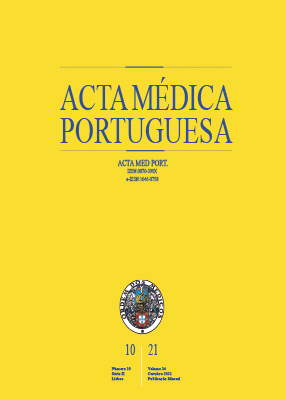Toscana Virus: Ten Years of Diagnostics in Portugal
DOI:
https://doi.org/10.20344/amp.13308Keywords:
Phlebovirus, PortugalAbstract
Introduction: Toscana virus (TOSV) is an emerging sandfly-borne virus within the Phlebovirus genus. Although most infections caused by this virus present as asymptomatic or with minimal symptomatology, TOSV may emerge as a febrile disease or sporadic cases of neurological disease such as meningitis or meningoencephalitis. This pathogen is distributed throughout the Mediterranean basin, along with the spatial distribution of its recognized sandfly vector, Phlebotomus perniciosus. Portugal, after Italy, was the second country considered endemic for this virus, with the first case of acquired infection published in 1985. Although little is known about the circulation of this virus in Portugal, the laboratory diagnosis of TOSV is available at the Centre for Vectors and Infectious Diseases Research of the National Institute of Health Dr. Ricardo Jorge (CEVDI/INSA), since 2007. The aim of this study is to report the results of the diagnosis of TOSV at the CEVDI/INSA, between 2009 and 2018.
Material and Methods: The diagnosis of TOSV in the CEVDI/INSA is included in the arboviruses and vector-borne neurotropic viruses panels or can be performed, when specified, for TOSV only. Direct detection is made in cerebrospinal fluid samples and is available for TOSV by specific real-time reverse transcription polymerase chain reaction followed by conventional real-time reverse transcription polymerase chain reaction for sequencing purposes, if positive. For indirect diagnosis, performed in serum samples, an in-house immunofluorescence assay for the detection of IgM and IgG antibodies against TOSV is used. A commercial immunofluorescence assay consisting in a mosaic of four phleboviruses is also available, in which, in addition to TOSV, antibody detection for sandfly fever Naples virus, sandfly fever Sicilian virus and sandfly fever Cyprus virus can be done. All diagnostic tests requested by clinicians to the CEVDI/INSA for arboviruses, neurotropic viruses and/or TOSV between January 2009 and December 2018, were included in this study.
Results: During the study period, the CEVDI/INSA received samples from 608 patients with diagnostic requests for TOSV. Five acute TOSV infections and one acute sandfly fever Sicilian virus infection were confirmed in serum samples. Three other patients had serological evidence of previous contact with the virus. Two of the six patients with acute infection developed febrile syndrome, and the other four presented with neurological disease: meningitis (n = 2), meningoencephalitis (n = 1) and severe depression of consciousness (n = 1). These infections were most likely acquired in the districts of Faro (3), Lisbon (2) and Setúbal (1).
Discussion: In Portugal, the number of laboratory diagnostic requests for TOSV is low when compared to the numbers of requests for other less prevalent vector-borne viruses. The Faro district presented the highest number of TOSV-specific diagnostic requests which seems to indicate a higher level of recognition by clinicians in that region. Febrile syndrome and neurological disease were the clinical manifestations that were present in acute cases. In this study, in addition to the Faro district, recent infections were also detected in the districts of Lisbon and Setúbal. It is probable that TOSV may be distributed throughout the mainland territory since its main vector is present from north to south. In 2017, the sandfly fever Sicilian virus was associated for the first time with human disease in our country, thus alerting to the circulation of this phlebovirus.
Conclusion: Even though the number of identified cases in Portugal is low, TOSV circulates and causes disease in our country. The diagnosis of this and other phleboviruses should not be neglected in the differential diagnosis of febrile syndrome and viral meningitis and meningoencephalitis, especially during the warmer months, when the vector’s activity is higher.
Downloads
Downloads
Published
How to Cite
Issue
Section
License
All the articles published in the AMP are open access and comply with the requirements of funding agencies or academic institutions. The AMP is governed by the terms of the Creative Commons ‘Attribution – Non-Commercial Use - (CC-BY-NC)’ license, regarding the use by third parties.
It is the author’s responsibility to obtain approval for the reproduction of figures, tables, etc. from other publications.
Upon acceptance of an article for publication, the authors will be asked to complete the ICMJE “Copyright Liability and Copyright Sharing Statement “(http://www.actamedicaportuguesa.com/info/AMP-NormasPublicacao.pdf) and the “Declaration of Potential Conflicts of Interest” (http:// www.icmje.org/conflicts-of-interest). An e-mail will be sent to the corresponding author to acknowledge receipt of the manuscript.
After publication, the authors are authorised to make their articles available in repositories of their institutions of origin, as long as they always mention where they were published and according to the Creative Commons license.









